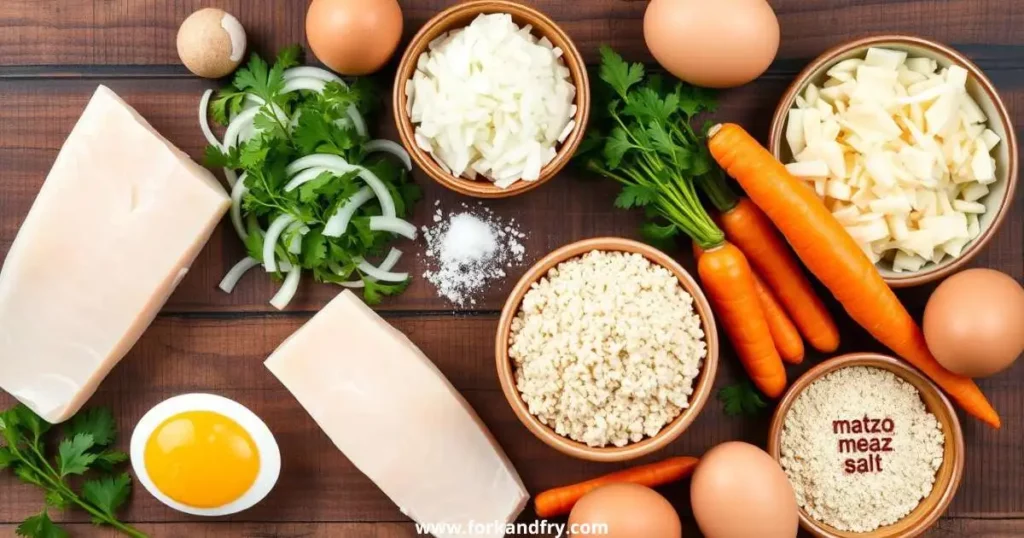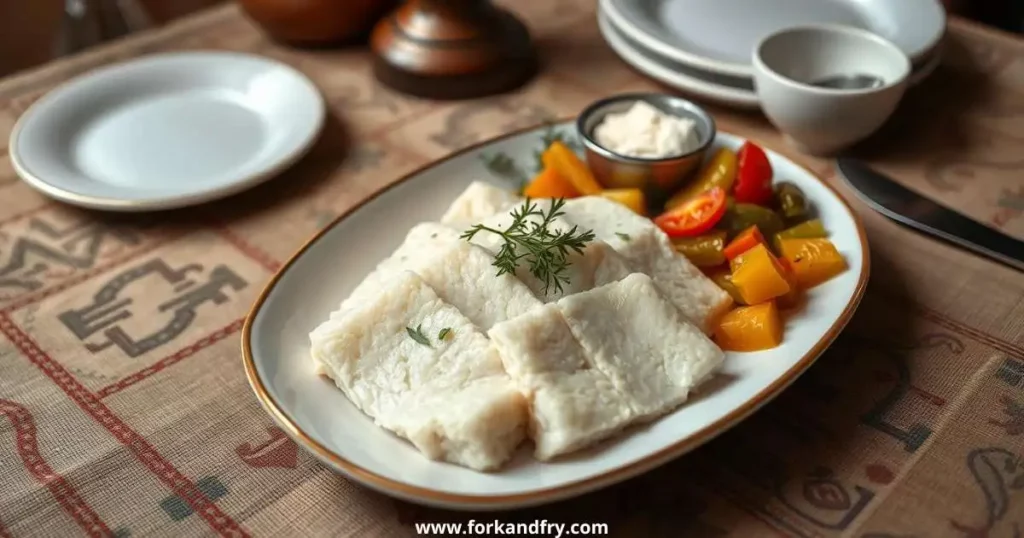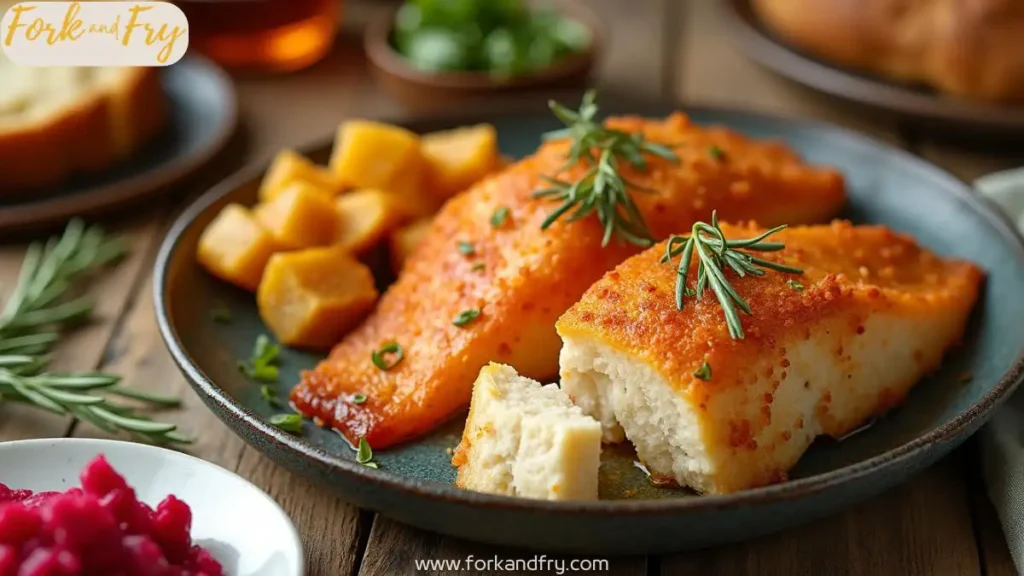Last updated on November 22nd, 2024 at 02:43 pm
Table of Contents
Welcome to the world of gefilte fish, a beloved dish in Jewish cuisine. It’s often enjoyed at holiday gatherings and family celebrations. To make this dish, you need to know the key ingredients that make it special.
Gefilte fish is made from a mix of fish like carp, whitefish, and pike. It also includes binding agents and seasonings that make it taste great. Knowing these ingredients is important for making your own gefilte fish and understanding Jewish culinary traditions.

Key Takeaways
- Gefilte fish is a traditional Jewish dish with roots in Eastern European cuisine.
- Key ingredients include various types of fish, such as carp and whitefish.
- Binding agents and seasonings are essential to the recipe’s flavor.
- Understanding the ingredients is vital for recreating authentic gefilte fish.
- This dish is culturally significant in Jewish life.
Understanding Gefilte Fish: A Brief Overview
Gefilte fish comes from Jewish cooking traditions, especially in Eastern Europe. It’s made from ground fish and is a big part of holidays and family gatherings. It’s a culinary tradition, a taste of history.
In the past, Jewish gefilte fish was made with what fish was available. Cooks mixed local fish with spices and other gefilte fish ingredients to improve taste and texture. Today, it still has its traditional taste but also meets new tastes.
Gefilte fish’s importance in Jewish culture shows its lasting charm. It has traveled from its beginnings to today, keeping its heritage alive.

| Year | Significance |
|---|---|
| 18th Century | Popularized in Eastern European Jewish households |
| Passover | Essential part of the Seder meal |
| Modern Era | Available in various interpretations and styles |
Traditional Gefilte Fish Ingredients
Exploring traditional gefilte fish ingredients reveals a mix of components that make it special. This mix boosts the dish’s flavor and texture. It’s a classic enjoyed during Jewish holidays.
Common Fish Types Used
Gefilte fish is made with various types of fish. The most common are:
- Carp
- Whitefish
- Pike
Each fish adds its own flavor and texture. This makes gefilte fish a favorite in many Jewish homes.
Essential Seasoning Components
Flavor is key in traditional gefilte fish. The main seasonings are:
- Salt
- Sugar
- Pepper
These seasonings boost the fish’s natural taste. They make the dish perfect for special occasions.
The Role of Binder Ingredients
Binder ingredients are vital for a cohesive texture in gefilte fish. Common binders are:
- Matzo meal
- Bread crumbs
These binders keep the mixture together. They ensure each bite is tasty and satisfying. The quality of ingredients is crucial for a great dish.

Jewish Gefilte Fish: Cultural Significance
Gefilte fish is a beloved Jewish dish. It’s a key dish on holiday tables, especially during Passover. It symbolizes heritage and community.
Preparing gefilte fish is a family affair. It brings everyone together in the kitchen. This makes the meal more than just food; it’s a way to connect and share memories.
As you try different recipes, you’ll see how gefilte fish has changed. It keeps its roots but also tries new things. This shows it’s a dish that adapts to the times.
Enjoying gefilte fish together is a big deal. It’s a time to think about family history and culture. Whether it’s the first bite or the last, it brings everyone closer.

| Aspect | Significance |
|---|---|
| Culinary Tradition | Represents centuries of Jewish heritage |
| Family Gatherings | Strengthens bonds through shared cooking experiences |
| Memory and Remembrance | Evokes feelings associated with celebrations and rituals |
| Modern Adaptations | Keeps the dish relevant in today’s culinary scene |
| Community Connection | Fosters a spirit of togetherness during feasting |
Variations in Gefilte Fish Ingredients
Gefilte fish has many different versions, shaped by culture and taste. These changes come from local tastes and new cooking ideas. Learning about these changes helps us appreciate this classic dish more.
Regional Differences in Ingredients
Every Jewish community has made gefilte fish their own. Ashkenazi recipes often use fish like carp or pike. Meanwhile, Sephardi recipes might include fish from the Mediterranean. The type of fish changes the taste and feel of the dish.
Here’s a look at what different traditions prefer:
| Tradition | Common Fish | Seasonings | Binder Ingredients |
|---|---|---|---|
| Ashkenazi | Carp, Pike | Onion, Caraway | Matzo meal, Eggs |
| Sephardi | Red mullet, Snapper | Cilantro, Cumin | Bread crumbs, Egg whites |
Modern Takes on Gefilte Fish
Chefs today are adding new twists to gefilte fish. They use spices like ginger or lemongrass to give it a fresh taste. They also serve it in new ways, like with sauces and garnishes.
These changes show how versatile gefilte fish is. They keep its tradition alive while bringing in new ideas.
Preparing Homemade Gefilte Fish
Making your own gefilte fish is a fun experience in the kitchen. First, pick the right fish. Whitefish, pike, and carp are popular choices. Using high-quality ingredients makes a big difference in taste and texture.
Next, grind the fish. A food processor is best for a smooth mix. Mix the ground fish with salt, pepper, sugar, onion, and carrot for flavor.
Binders help shape the fish. Matzo meal or breadcrumbs are good choices. Blend the batter well, then shape into loaves or balls. Make sure they’re all the same size for even cooking.
Poaching is key for cooking gefilte fish. Boil water with garlic, parsley, and veggies for flavor. Simmer the water, then add your shaped fish. Cook for 40 minutes, or until firm. Let them cool before serving.
Making homemade gefilte fish is rewarding. It lets you try new flavors and add a personal touch that store-bought can’t match.
| Step | Description |
|---|---|
| Select Fish | Choose fish like whitefish, pike, or carp for optimal flavor. |
| Grind Fish | Use a food processor for a smooth consistency. |
| Mix Ingredients | Add seasonings and binder to the ground fish. |
| Shape Mixture | Form into uniform loaves or balls. |
| Poach | Cook in flavored water until firm, about 40 minutes. |
Store-Bought vs. Homemade Ingredients
Choosing between store-bought and homemade gefilte fish can change your cooking experience. Knowing the good and bad of each helps you pick what’s best for you.
Pros and Cons of Each Option
Store-bought gefilte fish is super convenient. You can find it in many stores, making cooking faster. Store-bought might not match homemade flavor.
Making gefilte fish at home lets you add your own special touches. You can pick the best ingredients and try new flavors. It takes more time, but it’s worth it for a fresh, tasty dish.
| Aspect | Store-Bought Gefilte Fish | Homemade Gefilte Fish |
|---|---|---|
| Convenience | Quick and easy to prepare | Requires preparation time |
| Flavor | Consistent but may lack freshness | Rich, customizable flavors |
| Ingredient Control | Limited to manufacturer’s selection | You choose quality and proportions |
| Cost | Often less expensive in bulk | Potentially higher initial costs for quality ingredients |
Exploring Baked Gefilte Fish Recipes
Baked gefilte fish is gaining fans who want something different from the usual poached version. It offers a unique taste and texture that can really impress you. Its beauty lies in its taste and how versatile it is.
When making baked gefilte fish, you use classic ingredients. You’ll need fresh fish, like whitefish or pike, matzo meal, eggs, and spices. Each part is important for a great taste.
To give baked gefilte fish a modern twist, add extra flavors. Here are some ideas:
- Add fresh herbs like dill and parsley for a bright taste.
- Include finely chopped carrots and onions in the mix.
- Try a bit of garlic or lemon zest for a zesty kick.
The way you cook it can also change. You can bake it in a loaf pan or make patties. Serving it with roasted veggies or a tangy salad makes the meal even better. Baked gefilte fish keeps traditions alive while inviting new ideas into the kitchen.
Health Considerations for Gefilte Fish Ingredients
It’s important to know how the ingredients in gefilte fish affect our health. This section talks about the good and bad in traditional gefilte fish recipes. It helps those with health concerns make better choices.
Nutritional Breakdown of Common Ingredients
Each part of gefilte fish has its own health benefits. Let’s look at some common ingredients:
| Ingredient | Calories | Protein (g) | Fat (g) | Carbohydrates (g) |
|---|---|---|---|---|
| Whitefish | 145 | 23 | 5 | 0 |
| Carrots | 41 | 1 | 0.2 | 10 |
| Onions | 40 | 1 | 0.1 | 9 |
| Eggs | 68 | 6 | 5 | 1 |
| Matzo Meal | 120 | 4 | 0.5 | 26 |
Potential Allergens in Traditional Recipes
While gefilte fish is nutritious, some ingredients can cause allergies. Knowing the common allergens is key:
- Fish: People with fish allergies should stay away from gefilte fish.
- Eggs: Eggs can cause reactions in those with egg allergies.
- Gluten: Matzo meal has gluten, which is a problem for those with gluten issues.
Storage and Shelf Life of Gefilte Fish Ingredients
Storing gefilte fish ingredients right is key to keeping them fresh and tasty. Follow some important storage tips to keep your ingredients fresh. Always store fresh fish in the fridge at a temperature under 40°F (4°C). Try to use the fish within two days for the best taste and quality.
Freezing is a good choice for leftover gefilte fish or its parts. Wrap them tightly in plastic wrap or foil, then put them in airtight containers. This way, gefilte fish can stay good for up to three months without losing much flavor. Don’t forget to label your containers with the date.
When it comes to ingredients like matzo meal or eggs, check their expiration dates. Store matzo meal in a cool, dry spot away from moisture. Eggs should stay in their carton in the fridge to stay fresh. Paying attention to these storage tips helps keep your gefilte fish ingredients tasty and safe for longer.
Conclusion
As we wrap up our look at gefilte fish ingredients, it’s clear this dish is deeply rooted in Jewish culture. Learning about the parts that make up authentic gefilte fish boosts your cooking skills. It also helps you appreciate its rich history.
Knowing about common fish, key seasonings, and binders lets you make a dish that respects tradition. You can also try new things. By blending the familiar with the new, you create a unique culinary experience.
Whether you make gefilte fish at home or buy it, knowing what’s in it is important. The mix of flavors, health benefits, and allergens matter. Each ingredient connects you to the shared and family values of this iconic Jewish dish.
In the end, celebrating gefilte fish is about honoring its classic recipes and modern twists. You can keep the tradition alive by trying new ingredients or methods. This way, you create dishes that connect with both the past and today.
FAQ
What are the essential gefilte fish ingredients?
Traditional gefilte fish needs ground fish like carp, whitefish, or pike. It also needs binders like matzo meal or bread crumbs. Salt, sugar, and pepper add flavor.
Is homemade gefilte fish healthier than store-bought?
Making gefilte fish at home lets you choose better ingredients. This means fresher and higher quality. Store-bought might have preservatives and fillers that aren’t as good.
What are some common fish types used in Jewish gefilte fish?
Jewish gefilte fish often uses carp, whitefish, and pike. These fish give it the classic taste and texture.
How do I prepare baked gefilte fish?
Mix ground fish with the right ingredients, then shape into a loaf. Put it in a dish with broth or water. Bake until it’s done. This method makes it taste and feel great.
What are potential allergens in traditional gefilte fish recipes?
Traditional gefilte fish might have fish and gluten from bread or matzo meal. Please check the ingredients to ensure there are no allergens present.
How should I store leftover gefilte fish?
Refrigerate leftovers in an airtight container. It lasts 3-4 days. For longer-term storage, you can freeze the gefilte fish.
What are modern takes on gefilte fish?
Modern gefilte fish might add herbs, spices, or veggies. This makes it taste new while keeping its traditional feel.
Can you recommend any variations in gefilte fish ingredients across different cultures?
Yes, Ashkenazi and Sephardi gefilte fish recipes differ. Sephardi recipes might use cumin and coriander for a unique taste. Ashkenazi recipes are simpler.





